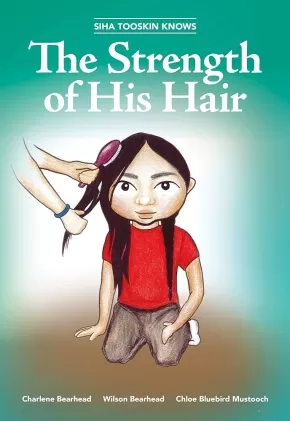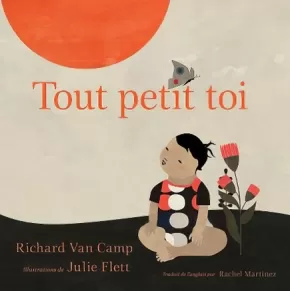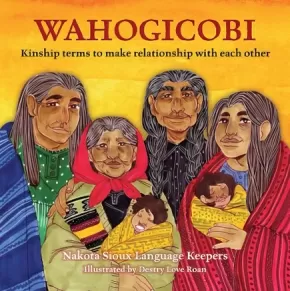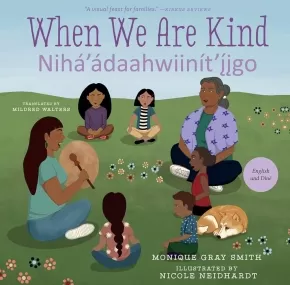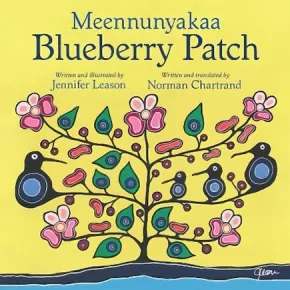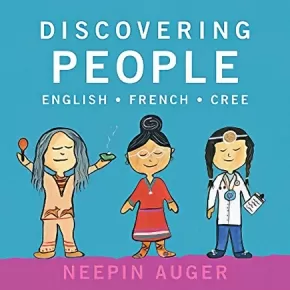
Canadian Indigenous Resource Lists
166
-
180
of
473 Results;
Sort By
Go To
of 32
Siha Tooskin Knows the Sacred Eagle Feather
$11.95
Format:
Paperback
Text Content Territories:
Indigenous Canadian; First Nations; Stoney-Nakoda (Nakota);
ISBN / Barcode: 9781553798491
Synopsis:
Synopsis:
For as long as Paul could remember there were eagle feathers around him…but how had they come to be in all of those places in his life?
Paul Wahasaypa—Siha Tooskin—already knows that the eagle is important because of the way that his family respects and cares for eagle feathers. Now he’s old enough for the teachings of where the feathers come from and why they are so sacred. Walk with Paul and Mitoshin (his grandfather) so you too will understand the teaching of the sacred eagle feather.
The Siha Tooskin Knows series uses vivid narratives and dazzling illustrations in contemporary settings to share stories about an 11-year-old Nakota boy.
Educator & Series Information
The Siha Tooskin Knows series uses vivid narratives and dazzling illustrations in contemporary settings to share stories about an 11-year-old Nakota boy. Explore Nakota culture and traditions alongside Paul Wahasaypa and his community in this eight-book series.
Key Features:
- A coming-of-age story about a Nakota boy learning about his identity and developing a sense of cultural responsibility in a contemporary, urban setting. Also touches on issues of environmental ecology and bullying.
- Charlene Bearhead and Wilson Bearhead are both well-respected and accomplished educators and storytellers.
- A part of the Siha Tooskin Knows series with teachings that show an Indigenous community and family in a positive light.
- Nakota lessons aim for universality, informing both Indigenous and non-Indigenous readers.
- This book illustrates how traditional teachings can play a vital role in contemporary life.
- Dynamic illustrations by Nakota artist Chloe Bluebird Mustooch bring this story to life.
Recommended for ages 9 to 11. Early Chapter Books.
Recommended in the Canadian Indigenous Books for Schools 2020/2021 resource list for Grades 3 to 6 in the areas of English and Social Studies.
Includes a glossary with Nakota words.
Keywords/Themes/Subjects: Nakota, Eagle Feathers, Customs and Traditions, Culture, Connectedness to Plants and Animals.
Additional Information
32 pages | 5.50" x 8.00" | Colour Illustrations
Siha Tooskin Knows the Strength of His Hair
$11.95
Format:
Paperback
Text Content Territories:
Indigenous Canadian; First Nations; Stoney-Nakoda (Nakota);
ISBN / Barcode: 9781553798378
Synopsis:
Synopsis:
Where can you find strength when someone disrespects you? And what does having strength really mean?
Paul Wahasaypa—Siha Tooskin—has learned from Ena (his mom) and Ade (his dad) to maintain a strong mind, heart, and spirit. Though starting at a new school can be hard, especially when the kids there have never experienced the values and culture of the Nakota people. Join Paul as Mitoshin (his grandfather) helps remind him how strength of character can be found in the strength of his hair.
The Siha Tooskin Knows series uses vivid narratives and dazzling illustrations in contemporary settings to share stories about an 11-year-old Nakota boy.
Educator & Series Information
The Siha Tooskin Knows series uses vivid narratives and dazzling illustrations in contemporary settings to share stories about an 11-year-old Nakota boy. Explore Nakota culture and traditions alongside Paul Wahasaypa and his community in this eight-book series.
Key Features:
- A coming-of-age story about a Nakota boy learning about his identity and developing a sense of cultural responsibility in a contemporary, urban setting. Also touches on issues of environmental ecology and bullying.
- Charlene Bearhead and Wilson Bearhead are both well-respected and accomplished educators and storytellers.
- A part of the Siha Tooskin Knows series with teachings that show an Indigenous community and family in a positive light.
- Nakota lessons aim for universality, informing both Indigenous and non-Indigenous readers.
- This book illustrates how traditional teachings can play a vital role in contemporary life.
- Dynamic illustrations by Nakota artist Chloe Bluebird Mustooch bring this story to life.
Recommended for ages 9 to 11. Early Chapter Books.
Recommended in the Canadian Indigenous Books for Schools 2020/2021 resource list for Grades 3 to 6 in the areas of English and Social Studies.
Keywords/Themes/Subjects: Nakota Culture, Respect, Body, Mind, and Spirit.
Includes a Nakota glossary.
Additional Information
24 pages | 5.50" x 8.00" | Colour Illustrations
The Eagle Mother
$23.00
Artists:
Format:
Hardcover
Text Content Territories:
Indigenous Canadian; First Nations; Gitxsan (Gitksan);
ISBN / Barcode: 9781553798590
Synopsis:
Synopsis:
Return to the valleys of the River of Mists with award-winning author Hetxw'ms Gyetxw (Brett D. Huson). Nox xsgyaak, the eagle mother, cares for her brood in the embrace of a black cottonwood with the help of her mate. Will both eaglets survive the summer in an environment that is both delicate and unforgiving?
Learn about the life cycle of these stunning birds of prey, the traditions of the Gitxsan, and how bald eagles can enrich their entire ecosystem. Evocative illustration brings the Xsan's flora and fauna to life for middle years readers in book three of the Mothers of Xsan series.
Reviews
“The Eagle Mother by Hetxw’ms Gyetxw (Brett D. Huson) and illustrator Natasha Donovan, the third in the Mothers of Xsan series, which offers a perspective on the life cycle of animals important to the land and to people.”— Publishers Weekly
"For further learning about the Gitxsan, the author has included a glossary titled "The Gitxsan Moons" and a summary of Gitxsan Nation clans" - Canadian Indigenous Books for Schools 2020/2021
Educator & Series Information
Recommended ages: 9 to 12 (Grades 3 to 7).
This is the third book in the Mothers of Xsan series, which uses striking illustration and lyrical language to bring the poetry of the Xsan ecosystem to life. The traditional Gitxsan formline art and language weave together throughout the stories in this series to paint a vivid picture of the Gitxsan people.
The Mothers of Xsan series is a collection of stories that connect the world to the matrilineal society of the Gitxsan people, located in Northwestern British Columbia. It presents scientific knowledge in language and a format that is accessible. Each book in the series showcases the depth and importance of the knowledge that has been gathered and shared through this unique style of storytelling. The stories of life cycle, connection the land and language are told from the perspective of the Mothers of Xsan system's animals.
Recommended in the Canadian Indigenous Books for Schools 2020/2021 resource list as being useful for grades 1-4 in the areas of Language Arts, Science, and Social Studies.
Additional Information
32 pages | 6.50" x 10.00"
The Train
$19.95
Artists:
Format:
Hardcover
Text Content Territories:
Indigenous Canadian; First Nations; Mi'kmaq;
ISBN / Barcode: 9781772601299
Synopsis:
Synopsis:
“I’m waiting for what we lost that day to come back to us.”
Ashley meets her great-uncle by the old train tracks near their community in Nova Scotia. When she sees his sadness, he shares with her the history of those tracks. Uncle tells her that during his childhood the train would bring their community supplies, but there came a day when the train took away with it something much more important. One day he and the other children from the reserve were taken aboard and transported to residential school, where their lives were changed forever. They weren't allowed to speak Mi'gmaq and were punished if they did. Uncle tells her he tried not to be noticed, like a little mouse, and how hard it was not to have the love and hugs and comfort of family. He also tells Ashley how happy she and her sister make him. They are what give him hope. Ashley promises to wait with her uncle as he sits by the tracks, waiting for what was taken from their people to come back to them.
Awards
- Co-winner of Second Story Press's Indigenous Writing Contest in 2018
Educator Information
Recommended for ages 6 to 9 (grades 1 to 3)
The Train is an intergenerational story of healing from trauma. The legacy of abuse of North America's Indigenous peoples is something that affects all of us, and this book is another important resource to start that conversation with young people.
The Train can be empowering for children whose families and communities have lived through trauma, as they can learn about the history and that they are strong enough to carry that knowledge and be the change we need.
Subjects / Themes: Character Education: Empathy, Family, Friendship; History & Social Studies: Canadian History, First Nations and Indigenous Peoples; Reflecting Diversity.
This book is available in a dual-language (Mi'gmaq and English) format: Ga's / The Train
Additional Information
32 pages | 8.50" x 8.50" | colour illustrations | picture book
Tout petit toi
$19.95
Artists:
Format:
Hardcover
Text Content Territories:
Indigenous Canadian;
Grade Levels: Preschool;
ISBN / Barcode: 9781459825444
Synopsis:
Synopsis:
Richard Van Camp, reconnu à travers le monde à titre de conteur et d’auteur des ouvrages à succès Welcome Song for Baby et We Sang You Home, s’est associé à la grande illustratrice Julie Flett. Cet album cartonné destiné aux bébés et aux bambins rend hommage, avec tendresse, à l’enfant à l’intérieur de chacun. Grâce à ses illustrations contemporaines adorables, Tout petit toi est un ouvrage parfait pour être regardé, lu à voix haute ou même chanté à tous les petits qui vous entourent… ou qui partageront votre vie bientôt !
Educator Information
Recommended for ages 0-2.
This is the French translation of Little You.
This book is available in a dual-language hardcover format in English and Anishinaabemowin: Little You / Gidagaashiinh
Keywords: bébés, famille, nouveau-nés, poésie, autochtone.
Recommended in the Canadian Indigenous Books for Schools 2020/2021 resource list as a French resource.
Additional Information
32 pages | 8.00" x 8.00" | Hardcover
Wahogicobi: Kinship terms to make relationship with each other (BB)
$7.95
Artists:
Format:
Board Book
Text Content Territories:
Indigenous Canadian; First Nations; Stoney-Nakoda (Nakota); Alexis Nakota Sioux Nation;
ISBN / Barcode: 9781926696867
Synopsis:
Synopsis:
Our Aboriginal Elders tell of a time when animals and humans could speak to each other. When humans became too greedy and killed more animals than they needed for food, the Creator changed that relationship to protect the animals. So the Creator made a Spirit Animal to represent each one and granted them gifts they could give to people.
Spirit Animals teach, heal and inspire. Turtle carries North America on its back and symbolizes peace and balance. Bear is called “Grandfather” for its strength, leadership, confidence and courage. Coyote gifted us with fire and knowledge of herbs and food. Wolf taught us to hunt and form communities.
This book is a guide, and the meanings of the Spirit Animals featured here are only one interpretation. If you see these Spirit Animals or Totems reflected in your own life, you have received their gift.
Educator Information
Encourages learning of simple kinship phrases in English and Nakota Sioux.
Additional Information
24 pages | 6.99" x 6.99" | Board Book
We Learn from the Sun (HC)
$22.99
Artists:
Format:
Hardcover
Text Content Territories:
Indigenous Canadian; First Nations; Anishinaabeg;
ISBN / Barcode: 9781989122396
Synopsis:
Synopsis:
This richly illustrated book by writer David Bouchard and illustrator Kristy Cameron, weaves together Woodland style paintings with a rhythmic poem about the spiritual lessons that we can learn from the Sun and the seven sacred teachings.
Educator Information
David Bouchard is a bestselling author, speaker and educator. He is Canada’s most sought after public speaker. We Learn from the Sun is an Indigenous rhyming poem based on his best selling book Seven Sacred Teachings.
An accompanying lesson plan and resource guide entitled We Learn from the Sun: Lesson Plans and Resources can be found on our site as well.
This book is available in French: On apprend du soleil.
Recommended for ages 5 to 12.
This resource is included in the Canadian Indigenous Books for Schools 2020/2021 resource list for grades K to 7 for Language Arts.
Additional Information
34 pages | 11.00" x 9.00" | 26 colour illustrations
When We Are Kind (HC)
$21.95
Artists:
Format:
Hardcover
Text Content Territories:
Indigenous American; Indigenous Canadian;
ISBN / Barcode: 9781459825222
Synopsis:
Synopsis:
When We Are Kind celebrates simple acts of everyday kindness and encourages children to explore how they feel when they initiate and receive acts of kindness in their lives. Celebrated author Monique Gray Smith has written many books on the topics of resilience and reconciliation and communicates an important message through carefully chosen words for readers of all ages. Beautifully illustrated by artist Nicole Neidhardt, this book encourages children to be kind to others and to themselves.
Awards
- 2022 Forest of Reading Blue Spruce Award
- 2021 Saskatchewan Young Readers' Choice Awards - Shining Willow
Reviews
“A perfect addition to your bedtime routine, and would make a great gift for every teacher and librarian your child knows, so each school has a copy upon reopening.” — them.
“Simple statements have the resonance of affirmations and establish a clear chain of connectedness…A panoply of Indigenous characters is featured in rich detail. A visual feast for families interested in seeing the Native world through small, kind deeds.” — Kirkus Reviews
“An accessible picture book that will work well as a read-aloud in a group or for quiet reading alone. Whether at home or in the classroom, its pleasing repetition of phrases. such as 'I am kind when' and 'I feel', will appeal to young readers and invite re-reading. Highly Recommended.” — CM: Canadian Review of Materials
"When We Are Kind is a poem-like story that celebrates the simple acts of everyday kindness. The story encourages children to explore how they feel when they initiate and receive acts of kindness in their lives. It is an appropriate text for a younger audience, but it also has a relevant reminder message for older children." — The Dalai Lama Center
Educator Information
Recommended for ages 3 to 5.
Themes: Teaching Compassion, Being Kind, Family, Friendship, Gratitude
Simple, pointed text gives examples of how children can be kind to those around them, the different emotions that receiving kindness can make us feel, and how we maintain a connection with one another through acts of kindness within our community.
This book is also available in a dual-language format: When We Are Kind / Nihá’ádaahwiinít’íįgo
This book is also available in French: Nous sommes gentils
This book is available as a board book: When We Are Kind (BB)
This resource is recommended in the Canadian Indigenous Books for Schools 2020/2021 resource list for grades K to 4 for use in these areas: Career Education, English Language Arts, Social Studies.
Additional Information
32 pages | 9.00" x 9.00"
When We Are Kind / Nihá’ádaahwiinít’íįgo
$21.95
Artists:
Format:
Hardcover
Text Content Territories:
Indigenous American; Native American; Navajo (Diné); Indigenous Canadian;
Grade Levels: Preschool; Kindergarten;
ISBN / Barcode: 9781459827530
Synopsis:
Synopsis:
When We Are Kind celebrates simple acts of everyday kindness and encourages children to explore how they feel when they initiate and receive acts of kindness in their lives. Celebrated author Monique Gray Smith has written many books on the topics of resilience and reconciliation and communicates an important message through carefully chosen words for readers of all ages. Beautifully illustrated by artist Nicole Neidhardt, this book encourages children to be kind to others and to themselves.
Reviews
“A perfect addition to your bedtime routine, and would make a great gift for every teacher and librarian your child knows, so each school has a copy upon reopening.” — them.
“Simple statements have the resonance of affirmations and establish a clear chain of connectedness…A panoply of Indigenous characters is featured in rich detail. A visual feast for families interested in seeing the Native world through small, kind deeds.” — Kirkus Reviews
“An accessible picture book that will work well as a read-aloud in a group or for quiet reading alone. Whether at home or in the classroom, its pleasing repetition of phrases. such as 'I am kind when' and 'I feel', will appeal to young readers and invite re-reading. Highly Recommended.” — CM: Canadian Review of Materials
"When We Are Kind is a poem-like story that celebrates the simple acts of everyday kindness. The story encourages children to explore how they feel when they initiate and receive acts of kindness in their lives. It is an appropriate text for a younger audience, but it also has a relevant reminder message for older children."— The Dalai Lama Center
Educator Information
This picture book is the dual-language (English and Diné) edition of When We Are Kind. The translator for this work is Mildred Walters. Mildred Walters is Diné (Navajo) from Torreon, New Mexico, in the eastern region of the Navajo Nation. She has a bachelor of arts in linguistics, a master of arts in language, reading, and culture and a master of arts in information resources and library science. She currently works as a librarian for a Public Tribal Library in Sandia Pueblo, New Mexico, and has done so for 11 years. Mildred currently lives in Albuquerque, New Mexico.
This book is also available in French: Nous sommes gentils
This book is available as a board book in English: When We Are Kind (BB)
Recommended for ages 3 to 5.
Themes: Teaching Compassion, Being Kind, Family, Friendship, Gratitude
Simple, pointed text gives examples of how children can be kind to those around them, the different emotions that receiving kindness can make us feel, and how we maintain a connection with one another through acts of kindness within our community.
Additional Information
32 pages | 9.00" x 9.00"
A Promise Is a Promise: 30th Anniversary Edition
$7.95
Artists:
Format:
Paperback
Text Content Territories:
Indigenous Canadian; Inuit;
ISBN / Barcode: 9781773212937
Synopsis:
Synopsis:
When Allashua disobeys her parents and goes fishing on the sea ice, she has to use her wits to escape the Qallupilluit--the troll-like creatures her parents have always warned her about that live beneath the frozen surface of the sea. But the only way to break out of their grasp is through an exchange: Allashua can go free if she brings her brothers and sisters back to the sea ice instead. Allashua doesn't want to give them up, but what can she do? After all, a promise is a promise.
Educator Information
A Promise Is a Promise is a collaboration between award-winning storyteller Michael Kusugak and celebrated children's author Robert Munsch. This 30th anniversary edition brings all of the tension of the traditional Inuit story to a new generation of readers. Added features include a new foreword by Michael Kusugak on his role as a storyteller and the importance of storytelling in Inuit culture.
This resource is also available in French: Une Promesse, C'est Une Promesse
Additional Information
32 pages | 7.80" x 7.90"
Birdsong
$22.95
Artists:
Format:
Hardcover
Text Content Territories:
Indigenous Canadian; First Nations; Cree (Nehiyawak);
ISBN / Barcode: 9781771644730
Synopsis:
Synopsis:
A tender, luminous portrait of art, nature, and connecting across generations.
When a young girl moves from the country to a small town, she feels lonely and out of place. But soon she meets an elderly woman next door, who shares her love of arts and crafts. Can the girl navigate the changing seasons and failing health of her new friend? Acclaimed author and artist Julie Flett’s textured images of birds, flowers, art, and landscapes bring vibrancy and warmth to this powerful story, which highlights the fulfillment of intergenerational relationships and shared passions.
Awards
- TD Canadian Children's Literature Award
Educator Information
Recommended Ages: 3 to 8
Recommended Grade Range: Preschool to Grade 3.
Curriculum Connections: Family - Indigenous, Friendship, Emotions and Feelings, Nature, Seasons
Gorgeous artwork captures life cycles, changing seasons, and the passing of life, providing a gentle way to discuss difficult subject matter with youth including loneliness, death, and grief.
Guided Reading Level: L
RRL: 19
Common Core State Standards
W.2.3,5,7,8
SL.2.1,1b,1c,2,3,4,6
RF.2.3,3d,3f,4,4a,4c
L.2.3,4,4a,4d,5,5a,5b,6
Recommended in the Canadian Indigenous Books for Schools 2020/2021 resource list as being useful for grades K-2 in these areas: English Language Arts, Science, and Social Studies.
Additional Information
48 pages | 10.00" x 10.00"
Blueberry Patch / Meennunyakaa
$19.95
Artists:
Format:
Hardcover
Text Content Territories:
Indigenous Canadian; First Nations; Anishinaabeg; Ojibway; Saulteaux;
ISBN / Barcode: 9781926886589
Synopsis:
Synopsis:
Based in Duck Bay, Manitoba, in the 1940s, an Elder shares his experience of packing up to go out to collect blueberries, a traditional gathering that took place every summer. He describes the journey and landscape with humor and such vivid imagery that readers will see themselves there with him, boarding the trail of wagons from surrounding communities and heading east toward the blueberry patch. The Elder's stories offer a journey back in time and are complemented by images of fields of plump blueberries, tall green grass, bannock baking over an open fire, clear freshwater streams and the tents the people slept in.
Educator Information
Written in English and Anishinaabemowin. Includes a page of after-reading activities for kids at the back of the book that both test reading comprehension and encourage further inquiry and exploration.
Recommended for ages 6-8.
Themes: Manitoba, Berries, Food Sovereignty, Indigenous, Traditions, Food, Culture, Family, Community, Anishinaabe.
Includes a recipe for bannock.
Translated by Norman Chartrand.
Recommended in the Canadian Indigenous Books for Schools 2020/2021 resource list as being useful for grades K-3 in these areas: English Language Arts, Art, Math, Science, and Social Studies.
Additional Information
32 pages | 8.00" x 8.00"
Discovering Numbers: English, French, Cree - 2nd Edition (BB)
$12.00
Artists:
Format:
Board Book
Text Content Territories:
Indigenous Canadian; First Nations; Cree (Nehiyawak);
Grade Levels: Preschool; Kindergarten;
ISBN / Barcode: 9781771603317
Synopsis:
Synopsis:
This updated edition is expanded to include more numbers and new illustrations, making it an even finer resource for teaching the basics of counting in English, French, and Cree.
Neepin Auger’s books for children contain original, brightly coloured images and early education level concepts familiar to everyone. Playful and bold, this dynamic series will educate and entertain preschoolers, parents, and teachers alike.
In addition to the English words presented, the French and Cree equivalents are also given, making these some of the most dynamic and useful board books on the market, perfectly suitable for the classroom, library, and nursery.
Neepin Auger is a Cree artist, educator, and mother. Originally from the Bigstone Cree Nation in northern Alberta, she has been painting for over ten years, having studied art under her father, Dale Auger, a renowned First Nations artist and author of the award-winning children's book Mwâkwa Talks to the Loon: A Cree Story for Children.
Reviews
"Neepin Auger has created a simple board book that illustrates the numbers one to ten and includes the words in English, French and Cree. Bright, simple drawings attract the eye. The subjects are those familiar to Cree children but have universal application. This book and its companion Discovering Words will be useful in preschool and kindergarten classrooms, especially those introducing multiple languages." —Canadian Aboriginal Books for Schools, 2014-2015
Educator & Series Information
This book is part of Neepin Auger's Discovering series.
This is the 2nd, updated edition.
Additional Information
30 pages | 6.50" x 6.50" | 2nd Edition
Discovering People: English, French, Cree (BB)
$12.00
Artists:
Format:
Board Book
Text Content Territories:
Indigenous Canadian; First Nations; Cree (Nehiyawak);
Grade Levels: Preschool;
ISBN / Barcode: 9781771603270
Synopsis:
Synopsis:
The fourth book in this colourful and unique series introduces twenty-two basic words in English, French, and Cree relating to familiar people at home and in the community.
Neepin Auger's books for children contain original, brightly coloured images and early education level concepts familiar to everyone. Playful and bold, this dynamic series will educate and entertain preschoolers, parents, and teachers alike.
In addition to the English words presented, the French and Cree equivalents are also given, making these some of the most dynamic and useful board books on the market, perfectly suitable for the classroom, library, and nursery.
Educator & Series Information
Recommended for ages 3 and under.
This is the fourth book in a series of Discovering books from Neepin Auger.
Recommended in the Canadian Indigenous Books for Schools 2020/2021 resource list as being useful for grades K-1 in these areas: Career Education, English Language Arts, and Social Studies.
Additional Information
30 pages | 6.50" x 6.50"
Discovering Words: English, French, Cree - 2nd Edition (BB)
$12.00
Artists:
Format:
Board Book
Text Content Territories:
Indigenous Canadian; First Nations; Cree (Nehiyawak);
Grade Levels: Preschool; Kindergarten;
ISBN / Barcode: 9781771603294
Synopsis:
Synopsis:
This updated edition includes a few replacement words and new artwork, gently refreshing the content to help teach the basics of early language in English, French, and Cree.
Neepin Auger's books for children contain original, brightly coloured images and early education level concepts familiar to everyone. Playful and bold, this dynamic series will educate and entertain preschoolers, parents, and teachers alike.
In addition to the English words presented, the French and Cree equivalents are also given, making these some of the most dynamic and useful board books on the market, perfectly suitable for the classroom, library and nursery
Neepin Auger is a Cree artist, educator, and mother. Originally from the Bigstone Cree Nation in northern Alberta, she has been painting for over ten years, having studied art under her father, Dale Auger, a renowned First Nations artist and author of the award-winning children's book Mwâkwa Talks to the Loon: A Cree Story for Children.
Reviews
"Neepin Auger's alphabet board book uses the same bright, simple style of illustration as the companion Discovering Numbers. English, French and Cree words accompany each illustration. Only the English words, in fact, follow the alphabet while the French and Cree words are translations. The pictures will be familiar to Cree children and provide a useful introduction to the other languages." —Canadian Aboriginal Books for Schools, 2014-2015
Educator & Series Information
This book is part of Neepin Auger's Discovering series, for ages 3 and under.
This is the updated 2nd edition.
Additional Information
32 pages | 6.50" x 6.50" | 2nd Edition
Sort By
Go To
of 32




